1936-1987 Cadillac Series 67, 70, 72, 75/Fleetwood 75
Series 67
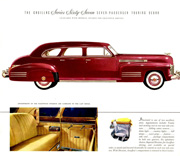 A bit of an oddball, the Series 67 rode on a slightly longer 139-inch wheelbase than the Series 75 136-inch wheelbase, though Series 75 was supposed to be the largest and most coach-built of all Cadillacs. All Series 75 models had exclusive bodies built by Fleetwood Body Company, while the longer Series 67 had a Fisher body, the company manufacturing all other Cadillac bodies. It was only produced two years, in 1941 and 1942.
A bit of an oddball, the Series 67 rode on a slightly longer 139-inch wheelbase than the Series 75 136-inch wheelbase, though Series 75 was supposed to be the largest and most coach-built of all Cadillacs. All Series 75 models had exclusive bodies built by Fleetwood Body Company, while the longer Series 67 had a Fisher body, the company manufacturing all other Cadillac bodies. It was only produced two years, in 1941 and 1942.
Series 70
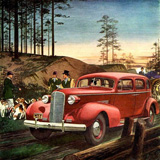 The Series 70 had a short run of two years for 1937 and 1938, but was revived for two years in 1957 to separate the exclusive Eldorado Brougham from other series. In 1937 it was similar to a Series 75, Cadillac’s top-of-the-line series, but with a shorter wheelbase. All of the bodies available with a Series 75 could be ordered on the shorter Series 70, and the same 346ci Monobloc V8 new this year.
The Series 70 had a short run of two years for 1937 and 1938, but was revived for two years in 1957 to separate the exclusive Eldorado Brougham from other series. In 1937 it was similar to a Series 75, Cadillac’s top-of-the-line series, but with a shorter wheelbase. All of the bodies available with a Series 75 could be ordered on the shorter Series 70, and the same 346ci Monobloc V8 new this year.
Series 72
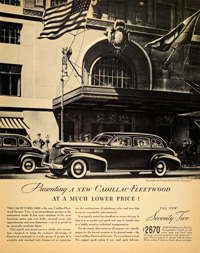 As confusing as Cadillac series were during the late-1930s and early 1940s, it only became more confusing with the Series 72 produced only one year, 1940. The Series 72 was similar to the Series 75, but on a shorter wheelbase—138-inches vs the 141-inches, the same basic model as the Series 70 dropped in 1938. Obviously Cadillac still felt there was a need for a virtually identical Series 75 but on a shorter wheelbase.
As confusing as Cadillac series were during the late-1930s and early 1940s, it only became more confusing with the Series 72 produced only one year, 1940. The Series 72 was similar to the Series 75, but on a shorter wheelbase—138-inches vs the 141-inches, the same basic model as the Series 70 dropped in 1938. Obviously Cadillac still felt there was a need for a virtually identical Series 75 but on a shorter wheelbase.
Fleetwood built these bodies, which included all of the body styles available in a Series 75. The Series 72 were slightly less expensive than the top-of-the-line Series 75. Besides the wheelbase the only other difference was the use of taillights placed high on the rear quarters for the Series 72.
Series 75 1936-1987
(Technically the 75 became the “Series 6700” in 1959. Many continued calling them Series 75 or “Fleetwood” since Fleetwood Body Co exclusively made Series 75 bodies and the cars had “Fleetwood” identification somewhere on them. At some point Cadillac went back to calling them “Fleetwood 75” but I think it’s correct to call all of the top-of-the-line Cads Series 75.)
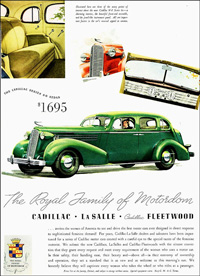 The flagship for Cadillac was the Series 75, first introduced in 1936. By 1938 Fleetwood Body Company was exclusively making Series 75 Cadillac bodies, further establishing the exclusivity of the Series 75. The series would be the largest Cadillacs and mostly on the longest wheelbases, but would also make available bare chassis for professional and specialized body builders for hearses, flower cars, station wagons, and large limousines.
The flagship for Cadillac was the Series 75, first introduced in 1936. By 1938 Fleetwood Body Company was exclusively making Series 75 Cadillac bodies, further establishing the exclusivity of the Series 75. The series would be the largest Cadillacs and mostly on the longest wheelbases, but would also make available bare chassis for professional and specialized body builders for hearses, flower cars, station wagons, and large limousines.
Fender and grille changes updated the Fleetwood bodies through 1940. Series 75 Cadillac was all-new with a more contemporary square shoulder design in 1941. Fenders were still separate but overall bodies were more integrated. Grilles were wide and encompassed the full width of the front ends. Headlights were integrated into the fenders. Series 75 was reduced to four-door sedans and limousines, and would remain with this basic body through 1949. Automobile production stopped early in the 1942 model run, to be picked up in 1945 as 1946 models.
An all-new Series 75 debuted in 1950 as a four-door sedan or limousine. Fully integrated bodies with a new chassis of 146.8-inches made for a whole new car. Power windows were standard. One-piece windshields were first available this year. It saw only trim and color changes for the most part before being replaced by the new body style in 1954. The 1953 “Imperial” limousine came with a glass partition as standard equipment.
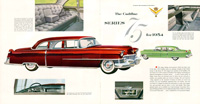 With wrap-around windshield and styling that mimicked the Series 60 and DeVille models, the 1954 Series 75 featured an even longer 149.8-inch wheelbase chassis, weighing 5,300-pounds. Dubbed the “high-headroom” Series 75 it featured a lower, sleeker body envelope with fins were more pronounced and massive front grille and bumper. This body remained basically unchanged except for trim and color options through 1956.
With wrap-around windshield and styling that mimicked the Series 60 and DeVille models, the 1954 Series 75 featured an even longer 149.8-inch wheelbase chassis, weighing 5,300-pounds. Dubbed the “high-headroom” Series 75 it featured a lower, sleeker body envelope with fins were more pronounced and massive front grille and bumper. This body remained basically unchanged except for trim and color options through 1956.
1957 saw a totally new Series 75, but also saw the two-year only Series 70 revived as the Eldorado Brougham four-door hardtop sedan. Frames were new “X-frame” to allow the bodies to be lower without losing any space inside. This was the first time in years that fender skirts were not available. Fins continued to grow, as did the wheelbase at 149.7-inches. This body lasted only two years.
The big-fin 1959 bodies were new but stayed on the same chassis as previous models. The Series 75 identification was dropped for “Series 6700”, but was mostly still referred to as Series 75. Again, this body style lasted only two years with slightly toned-down styling for 1960.
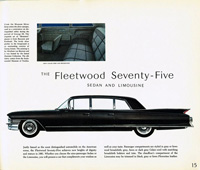 While the 1961 Series 75 picked up the regular Cadillac styling, it would stick with this basic body through 1965, not adopting the regular line’s all-new body and frame for 1965 until a year later in 1966. The series would pick up the major restyle in 1963, and would remain unchanged until the 1966 Series 75 debuted.
While the 1961 Series 75 picked up the regular Cadillac styling, it would stick with this basic body through 1965, not adopting the regular line’s all-new body and frame for 1965 until a year later in 1966. The series would pick up the major restyle in 1963, and would remain unchanged until the 1966 Series 75 debuted.
Besides picking up the new body a new full-perimeter frame and Hydra-matic automatic transmission were the other big improvements. In 1967 the extended tops proportionally looked good on these bodies with their long decks. Automatic level control, air conditioning and carpeted fold-down foot rests were all standard this year.
For 1969 another restyle tried to capitalize on the much heralded Eldorado design. Front fenders and grille mimicked the Eldo. Both the hood and rear fenders were extended. For Series 75 sedans the doors opening up into the roof for more clearance.
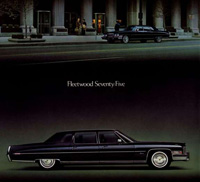 When Cadillac styling changed in 1971, the Series 75 did also. Now on a 151.5-inch wheelbase, the commercial chassis were even longer at 157.5-inches long. Record interior space and exterior size would be the last of the big Cadillacs before downsizing in 1977. A flat, wide hood emphasized the Mercedes-like grille treatment. The back of the top could be blind, without windows, or house an opera window and rear windows came as smaller private glass or larger sedan-like glass.
When Cadillac styling changed in 1971, the Series 75 did also. Now on a 151.5-inch wheelbase, the commercial chassis were even longer at 157.5-inches long. Record interior space and exterior size would be the last of the big Cadillacs before downsizing in 1977. A flat, wide hood emphasized the Mercedes-like grille treatment. The back of the top could be blind, without windows, or house an opera window and rear windows came as smaller private glass or larger sedan-like glass.
With the downsizing of the Cadillac line in 1977, the Series 75 now rode on a 144.5-inch wheelbase. The Fleetwood Limousine weighted 900-pounds less than the previous 1976 models. The last big block engines appeared in this era’s Series 75. Lasting through 1984 with only minor trim and grille changes, in 1985 Cadillac downsized again, with the Series 75 following suite. It now rode on a 134.4-inch wheelbase and came in at an even 4,000-pounds. 1987 would be the last year for the Series 75 and also limousine production at Cadillac.
Cadillac Fleetwood Series 75
Fleetwood is known as Cadillac’s top-of-the-line limousines and semi-custom bodies from back in the day, but its beginnings were much more humble. Fleetwood started as a custom body manufacturer called Fleetwood Metal Body Company in 1909. It was acquired by General Motors in the purchase of Fisher Body in 1929, who had 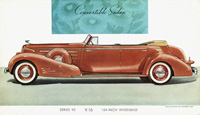 purchased Fleetwood in 1925. From 1925-29 Fleetwood Body built Cadillac bodies exclusively, offering them as an option from 1927-1934. After 1934 Fleetwood bodies were only available on the Series 75 and Series 90 Cadillacs, the most luxurious, largest and in most cases semi-custom bodies Cadillac made. Most all V12 and V16 Cadillacs had Fleetwood bodies.
purchased Fleetwood in 1925. From 1925-29 Fleetwood Body built Cadillac bodies exclusively, offering them as an option from 1927-1934. After 1934 Fleetwood bodies were only available on the Series 75 and Series 90 Cadillacs, the most luxurious, largest and in most cases semi-custom bodies Cadillac made. Most all V12 and V16 Cadillacs had Fleetwood bodies.
When General Motors started designating different mass production platforms in 1936 with letters, the largest platform became the D-Body. Though similar to GM’s C-Body, it was always used on Cadillac’s largest models like limousines, and for professional chassis used for ambulances, hearses and flower cars.
From 1941 until the end of limousine production in 1988 all Cadillac Series 75 limousines were “Fleetwood 75 Limousines.” Fleetwood script began to appear on Cadillacs starting in 1947, which were continuations of pre-war bodies. Fisher Body manufactured the newer bodies used for mainstream Cadillacs at this time. Fleetwood designated bodies in 1955-56 were slightly different with longer wheelbases from the more mainstream Fisher Body Cadillacs.
Fleetwood was designated as the body manufacturer for the Fleetwood Brougham from 1957-1960, though Pininnfarina actually manufactured the 1959-60 Broughams. With the addition of the Eldorado Biarritz in 1963 Fleetwood manufactured both the hardtop and convertible. Fleetwood crests appeared on the rear quarters and also on the rocker moldings.
The Eldorado, Sixty Special on the extended Cadillac chassis, and high end Series 75 models were placed under the Fleetwood banner, but there was no separate Fleetwood model until 1965 when it was used to designate the top-of-the-line models. One distinguishing characteristic of Fleetwood bodies in the 1960s and 1970s was the doors opening into the tops for easier access and a more formal, limousine look.
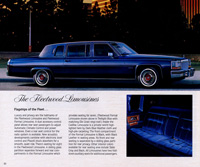 In 1977 the Sixty Special Brougham and Series 75 were renamed “Fleetwood Brougham” and “Fleetwood Limousine” respectively. In 1985 the Fleetwood name was used on the new front-wheel drive GM C-body platform, while the Brougham became a separate make on the rear-wheel drive GM D-body platform for a single year. In 1986 it became a DeVille option package, before becoming part of the Fleetwood Sixty Special on the stretched C-body platform, while the Fleetwood Series 75 used an even longer stretched C-body chassis. In this period there was a lot of back and forth with the Fleetwood designations and other models. In 1993 the Fleetwood name landed on the rear-wheel drive C-body four-door sedans. When this platform was retired in 1996 the Fleetwood name was retired as well.
In 1977 the Sixty Special Brougham and Series 75 were renamed “Fleetwood Brougham” and “Fleetwood Limousine” respectively. In 1985 the Fleetwood name was used on the new front-wheel drive GM C-body platform, while the Brougham became a separate make on the rear-wheel drive GM D-body platform for a single year. In 1986 it became a DeVille option package, before becoming part of the Fleetwood Sixty Special on the stretched C-body platform, while the Fleetwood Series 75 used an even longer stretched C-body chassis. In this period there was a lot of back and forth with the Fleetwood designations and other models. In 1993 the Fleetwood name landed on the rear-wheel drive C-body four-door sedans. When this platform was retired in 1996 the Fleetwood name was retired as well.